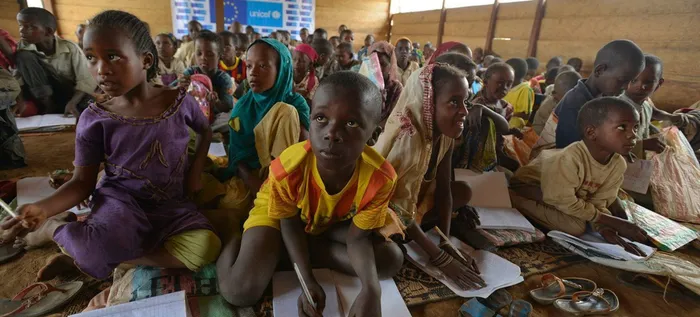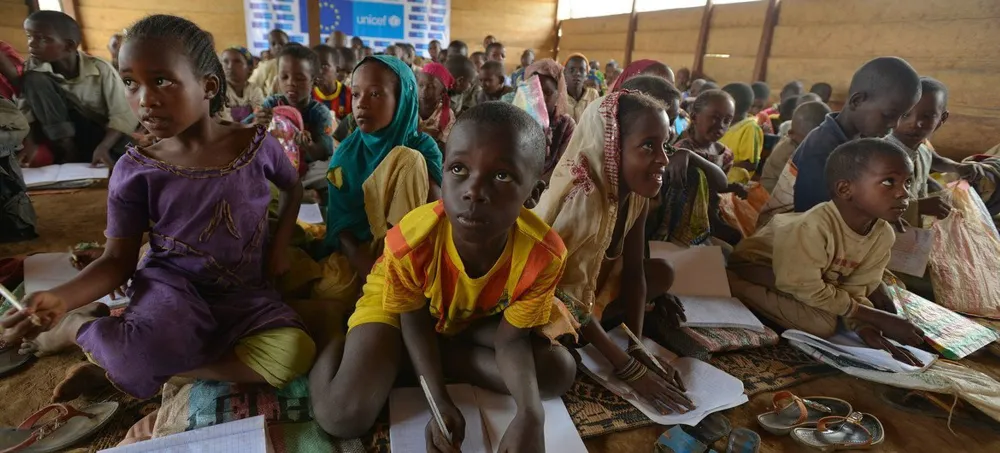Black African children remain highly under-represented in the best schools

Picture: UNICEF - Children from the Central African Republic attend class in a protected space at a refugee camp in the Cameroon.
Picture: Doctor Ngcobo/African News Agency (ANA) - Pupils from schools in Marianhill cross the uMhlathuzana river in Mpola using a make shift bridge built by locals. The bridge in the KwaZulu-Natal area was swept away by floods.
By Edwin Naidu
The African Union has set the tone on how science and technology as a priority can lift the Continent. The latest strategy took many a workshop over the past two decades, yet governments throughout Africa are failing to allocate at least one percent towards research and development in science and technology.
South Africa is committed towards investment in science and technology and has a formidable strategy to impact the greater good. However, increasingly, one senses that all initiatives may be a non-starter until the doomed foundation of matric as a school-leaving certificate and a key to a better future is dismantled.

While the AU strategy is contrasted against high-levels of poverty on the continent, South Africa is by no means alone. In a few months South Africa’s matric pupils will begin the annual pilgrimage towards national senior certificate (NSC) examinations that culminate in a public relations exercise early in the new year driven by the long-serving Minister of Basic Education Angie Motshekga. Far from taking their place in the so-called Fourth Industrial Revolution (4IR) optimistically spearheaded on paper by the African Union, in 2023, a large portion of learners finishing high school will instead join the millions of unemployed youth.
That has been pretty much the pattern since democracy in South Africa. Statistics from the department of basic education, reveal that 733 917 full-time candidates and about 162 793 part- timers registered for the NSC in November 2021, almost 900 000 in total. There were only 127 000 university places available for new students at public universities, at least 30% only furthering their studies. Annually, after 12 years of schooling, more than 400 000 matriculants make it to the unemployment line as their reward for completing South Africa’s matriculation examination.
There is no magic wand to address this crisis which sees on average 400 000 matric school leavers annually join the ranks of jobless for the economy is in precarious shape for a litany of reasons, inevitably, linked to bad governance, corruption and an environment that deters investment. Several countries on the continent, for example, have set up manufacturing plants in the automotive sector, once the domain of South Africa.
Yet, in South Africa a key ignored challenge is the reality that our focus has been on matric while varsities are not welcoming and the country’s 50 Technical and Training Vocational Colleges are yet to offer the quality training that would lead to careers to make a dent on the country’s unemployment statistics. Education experts were full of praise when the ruling ANC government successfully amalgamated the varying apartheid era-education establishments.
The country’s first education minister Professor Sibusiso Bengu once told me it was akin to changing the course of a plan mid-air to go back to its origins without crashing. While many would not have understood the gravitas of the job, not just for education, in retrospect one can assume that the liberation movement which became the governing party played to the sunshine clauses adopted by the then Government of National Unity.
A shocking failure for the ANC under the leadership of Nelson Mandela was redefining what it meant to be South African. Instead, the ruling party retained apartheid era-tags defining South Africans as
Black, white, Indian and coloured. As a result, racism as shown by the number of cases before the South Africa Human Rights Commission, is worsening. Surely, this goes back to education and decisively addressing the apartheid racism which still three decades after democratic rule is as strong as ever and entrenched in the psyche of our nation. On 28 March, in a seminar by the Human Sciences Research Council (HSRC) Seminar, on the theme School Segregation in Post-Apartheid South Africa University of Cambridge academic Dr Rob Gruijters and Dr Vijay Reddy, Distinguished Research Specialist at the Human Sciences Research Council, said school integration, especially in former white schools, is a prominent topic in South Africa, and incidents of exclusion and racism in schools regularly appear in the news.
The extent to which de facto school integration happened since the end of de jure segregation is an important indicator of the success of racial reconciliation in post-apartheid South Africa.
Studying school integration and diversity can also help us to understand the nature of social inequality in the post-apartheid era. While quantitative research on current patterns of school segregation remains limited, however. As a result, researchers and policymakers are forced to rely on “anecdotal evidence”. Their study, therefore, seeks to describe the patterns of between-school racial and socio-economic segregation in contemporary South Africa. In South Africa, former white schools continue to be the most prestigious and desirable schools.
It can be argued that the political settlement that emerged in post-apartheid South Africa was conducive to opportunity hoarding by the white minority and other socio-economically advantaged groups. Their study found that unlike the tertiary sector, there was no explicit government policy or guidance on school integration. School Governing Bodies (SGBs) consisting of parents and teachers received a broad mandate to set fee levels, catchment areas and other admission criteria. Previous research* suggests that school fees and admission criteria were used strategically by SGBs in former white schools to exclude undesirable (i.e. poor) applicants. The introduction of school fees, mainly in former white schools, at levels that are unaffordable for most of the population ensured that the continued legacy of apartheid spatial planning policies while private schools provide another option for opportunity hoarding.
The academics used data from the 2021 Annual School Survey, a census that looked students in Grade 1 to Grade 12 (13.3 million students) and the 2019 Trends in International Mathematics and Science Study (TIMSS). TIMSS is based on a nationally representative sample of around 20,000 Grade 9 students in more than 500 schools, looking at socio-economic segregation and its intersection with racial segregation. In both datasets, a students’ ‘race’ is measured using the census categories Black African, Coloured, White, and Asian / Indian.
Using the TIMSS data, the academics created a composite measure of student socio-economic status (SES) indicator based on household assets, parental education, and books at home. Based on this indicator, they divided children into middle class (top 24 percent) and working class (remaining 76 percent), in line with a recent World Bank report. Integration is the extent to which students of different groups are distributed evenly across schools. It is measured using the H-index. The inverse of integration is segregation. Indices of diversity measure the variety of racial groups present in a school In 2021, the average white student attended a school that was 68.5 percent white, 3.3 percent Asian, 8.5 percent coloured, and 19.6 percent black. Conversely, the average black student attended a school that was 0.9 percent white, 0.7 percent Asian, 2.0 percent coloured, and 96.4 percent black. However, the study said it could be argued that it is unrealistic to expect schools to reflect the national population distribution.
Instead, they checked whether schools are representing the population in their respective area.
Former white schools now admit 54.4 percent black learner. However, very few white children attend former black, Asian or coloured schools. Formerly black schools (which form the majority of all schools) remain almost exclusively black. Many of these schools are located in townships and rural areas, where there is little racial diversity. Schools may be racially diverse but not integrated (representative of the population). Former white schools are, on average, the most racially diverse, but they also contribute most to segregation, because white and Asian children remain strongly overrepresented in these schools, relative to their share in the population. But there is a difference between integration and diversity, especially in a context like South Africa where the vast majority of all children are black.
Top 30 public schools and top 30 independent schools were also identified based on their 2021 fee levels* and matched to Annual School Survey data. It is almost impossible to understand racial segregation in education without analysing its intersection with socio-economic segregation. Previous research has suggested that the integration of former white schools is often limited to the wealthiest children from another racial group. They used socio-economic segregation between schools, as well as its intersection with racial segregation.
South African students are not only segregated by race, but also by class (socio-economicstatus).
South Africa has the second-highest level of socio-economic segregation between schools among the 41 TIMSS countries, exceeded only by Turkey. The academics have said it is impossible to understand racial segregation in education without analysing its intersection with socio-economic segregation. Previous research has suggested that the integration of former white schools is often limited to the wealthiest children from other racial groups.
Regardless of how they measured it, school segregation in post-apartheid South Africa remains high along racial, as well as socio-economic lines. Many (but not all) former white schools are racially diverse to varying degrees and they are not representative of the population.
Black African children remain highly under-represented in the country’s best schools. Elite schools (both public and private) remain predominantly white. When white students have exposure to black classmates, they tend to be from the most socio-economically advantaged segments. In combination, these findings are in line with “opportunity hoarding” by the white minority and—to a much lesser extent—the new black middle class. The post-apartheid political settlement enabled privileged groups to monopolise access to the most attractive schools, leading one to question how South African matric pupils would benefit from the African Union’s Science Technology and Innovation Strategy 2024 when pupils are still not singing from the same page as a united nation?
Naidu is a journalist and communications expert. He currently heads the social enterprise initiative Higher Education Media Services.
This article is original to The African. To republish, see terms and conditions.